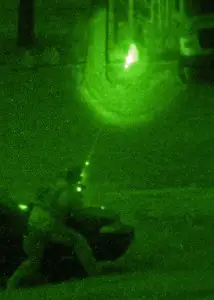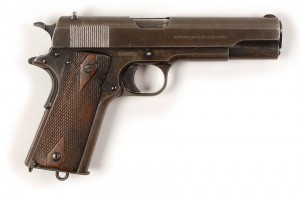
A Special Forces sniper engages a target during the night stress event at the 2010 USASOC Sniper Competition at Fort Bragg. US Army photo.
For the last 100 years, until quite recently, the range and striking power of small units’ individual and crew-served weapons hasn’t changed much even as the weapons have been revolutionized in portability, ergonomics, and targeting technology. This targeting technology is beginning to bleed over to range to some degree. The individual rifleman can make shots with an M4A1 or SCAR and a good optic (ACOG or Elcan) that even snipers did not take in the world wars, and the rifleman can dominate an open area in a way that only a machine gun crew could contemplate in the Great War, for example.
Why is range important? Because it drives development and planning of tactics, and determines who’s in the driver’s seat of any given engagement. In 1945, the insightful British officer Major General J.F.C. Fuller had this to say:
The weapon of superior reach or range should be looked upon as the fulcrum of combined tactics. Thus, should a group of fighters be armed with bows, spears, and swords, it is around the arrow that tactics should be shaped; if with cannon, muskets and pikes, then around the cannon; and if with aircraft, artillery, and rifles, then around the airplane.
Range, though, is not only the theoretical maximum capability of the weapons system (assuming proper sighting and laying-in and an optimum operator or crew), but the practical capability of the weapons system given the operator, conditions, weather and terrain at hand. Our rifleman are taking 500 and 600 meter shots with a 5.56mm carbine in Iraq and Afghanistan because they can. In the European environment of the world wars, even snipers were taking 200 and 300 meter shots, and in tropical triple-canopy jungle, a long shot is 100 meters.
There are other advantages, though, to having a long range weapon, beyond any intangibles like confidence. One is terminal ballistics. A weapon that can kill at 1000 meters can certainly kill at a lesser included range. (The problem, in fact, with the 600m M4 shot is not making the shot, but the weak terminal ballistics from the slowing 5.56 bullet). Another is accuracy. If you can strike a man’s-central-nervous-system size target at 600m, the weapons system will make 200m shots all day long.
The important measure of range is not an absolute, but a relative one. If you have superior killing range to your enemy, you have an open path to choose when to engage and disengage, and can refuse combat on the enemy’s terms and accept it — or force it -on yours.
 A good shooter knows the performance of his weapons system throughout its designed range — and even beyond. The average civilian shooter or police officer will never have an occasion to hit a man-sized target at 100m with a .45 M1911A1. The average guy probably doesn’t even think it’s possible. (It is, but not every shot with a GI gun. You need a tuned gun, but nothing exotic, to make it every-shot routine).
A good shooter knows the performance of his weapons system throughout its designed range — and even beyond. The average civilian shooter or police officer will never have an occasion to hit a man-sized target at 100m with a .45 M1911A1. The average guy probably doesn’t even think it’s possible. (It is, but not every shot with a GI gun. You need a tuned gun, but nothing exotic, to make it every-shot routine).
If you want to transcend the average, it can’t hurt to have some tools in your toolbox that the average guy can’t even imagine. And then hope your enemies are average guys.

Kevin was a former Special Forces weapons man (MOS 18B, before the 18 series, 11B with Skill Qualification Indicator of S). His focus was on weapons: their history, effects and employment. He started WeaponsMan.com in 2011 and operated it until he passed away in 2017. His work is being preserved here at the request of his family.

One thought on “Some thoughts on Range”
Didn’t know how else to send this to you; but it seems to fit a theme you return to.
http://deltabravosierra.com/comic/butter-bar-strikes-again/
Nice, thoughtful post on Range, btw.